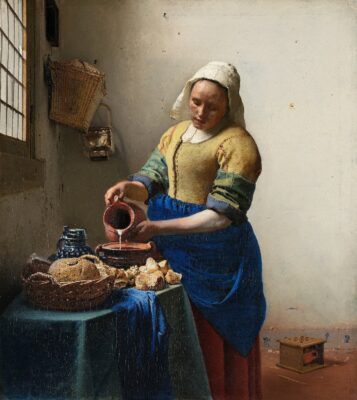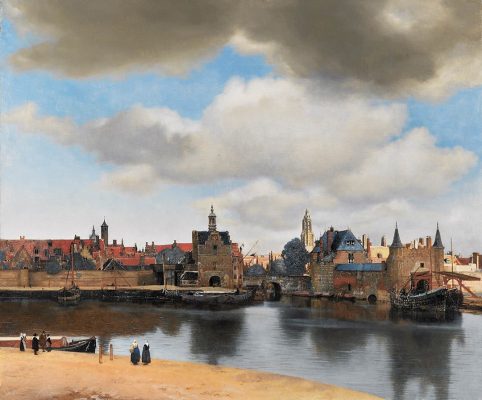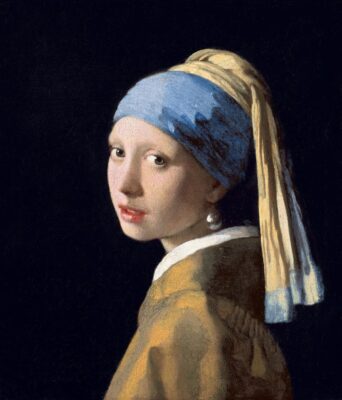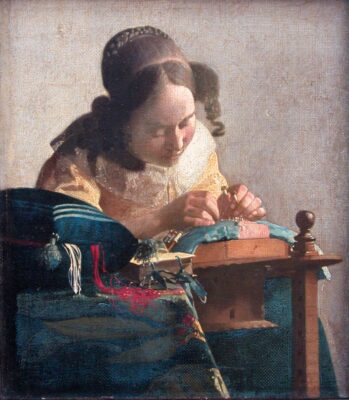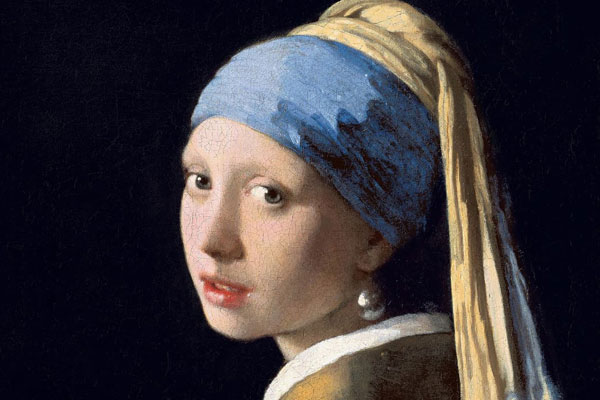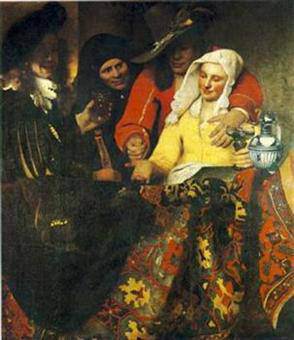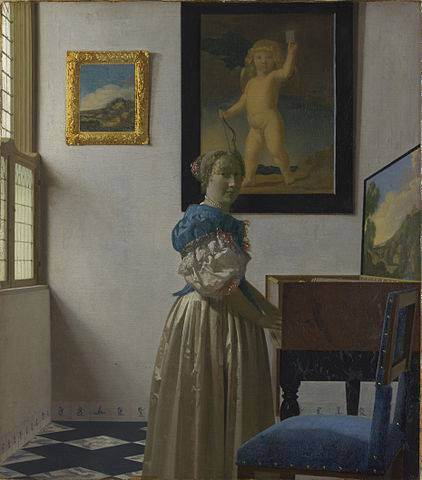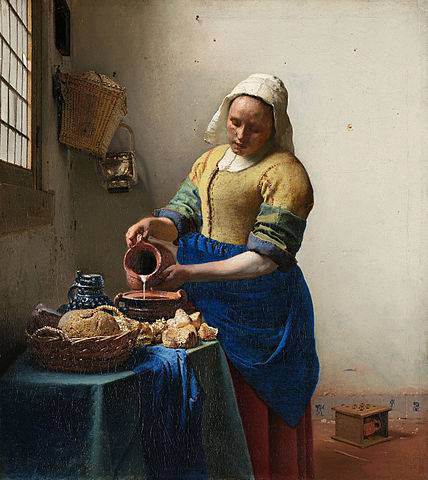Vermeer
“La esfinge de Delft”. Así describió el historiador Théophile Thoré a Vermeer, aludiendo a lo misterioso de su vida, aunque bien podría aplicarse, como indica Emilie Gordenker, directora del Mauritshuis, a la fascinación que su obra sigue despertando hoy en día. Pintor de muy escasa producción (poco más de 30 pinturas pueden atribuírsele con certeza), es no obstante el autor de varias de las obras más icónicas del barroco, como su “Vista de Delft o “La Joven de la Perla”, llamada a menudo “La Mona Lisa del Norte”.
Imagen: Imagen: posible autorretrato de Vermeer (fragmento de su cuadro “La alcahueta” (1655, óleo sobre lienzo, 143 x 130 cm. Gemäldegalerie Alte Meister)
No obstante, esta admiración hacia la figura de Vermeer no ha sido continua a lo largo de la historia. Tras su muerte, su figura cayó en el olvido, no siendo recuperada hasta principios del siglo XIX, siendo posteriormente apreciada por los impresionistas (Renoir llegó a decir que «La encajera» de Vermeer era una de las dos mejores pinturas del Louvre) y los pintores de vanguardia. Así, hacia 1925 «la opinión no dudó en considerar la perspectiva ‘vermeeriana’ como fuente de las abstracciones de Mondrian y de los interiores de Fernand Léger» (Pierre Descargues, «Vermeer de Delft», 1981)
Muy poco se sabe de la infancia y juventud de Vermeer. Fue bautizado en Delft en 1632, y desde esa fecha hasta su ingreso en el gremio de San Lucas, a finales de 1653, los datos sobre Vermeer son prácticamente inexistentes. Su primera pintura conocida es “Cristo en casa de Marta y María”, pintada hacia 1654 y 1655, y conservada en la Galería Nacional de Escocia, obra de no demasiado interés si se compara con las obras que Vermeer pintó durante la segunda parte de la década, como “La callejuela” o su famosa “La lechera” (ambas obras pintadas hacia 1657-58, y conservadas en el Rijksmuseum de Ámsterdam)
En 1660-61 (1659 según algunos autores), Vermeer pinta una de sus indiscutibles obras maestras, “Vista de Delft” (La Haya, Mauritshuis), la cumbre del paisajismo holandés del siglo XVII. De esta pintura se ha dicho que es la primera obra impresionista de la historia de la pintura, y Marcel Proust llegó incluso a asegurar que era “el más bello cuadro del mundo”. En 2006, theartwolf escogió a «Vista de Delft» como una de las 50 obras maestras de la pintura, y un breve análisis de la obra puede encontrarse en la página enlazada.
Vermeer: “La lechera”, hacia 1657-58. Óleo sobre lienzo, 45.5 × 41 cm. Ámsterdam, Rijksmuseum·· Vermeer: “Vista de Delft”, hacia 1660. Óleo sobre lienzo, 98.5 × 117.5 cm. La Haya, Mauritshuis
Durante la década que siguió a “Vista de Delft”, Vermeer alcanza su madurez, logrando un estilo único, delicado preciso hasta resultar casi fotorrealista, centrado en representar momentos cotidianos en pinturas de pequeño tamaño que invitan al espectador a acercarse al cuadro. Esta precisión en el estilo de Vermeer ha llevado a varios autores a opinar que el artista se sirvió de una cámara oscura para capturar las escenas, que posteriormente llevaría a la pintura. Y, sin embargo, esa precisión no impidió que, a medida que avanzaba la década, Vermeer fuese simplificando sus composiciones, eliminando lo superfluo y concentrándose en lo esencial. En su célebre “La Joven de la Perla”, Vermeer opta por un fondo completamente negro, permitiendo que el espectador se centre por completo en la mujer retratada. En la diminuta pero exquisita “La encajera”, considerada por Lawrence Gowing como “el logro de la madurez de Vermeer”, el artista opta por un un fondo neutro, casi abstracto, que no interfiere con los tonos suaves del vestido de la joven y de las telas del primer plano.
Tampoco sabemos demasiado de los últimos años de Vermeer, hasta su muerte a finales de 1675, siendo enterrado en la Iglesia Antigua de Ámsterdam. En 1672, los Países Bajos sufrieron el “Rampjaar”, o “El año del desastre”, una profunda crisis económica provocada por el estallido de la Guerra franco-neerlandesa. Entre este año y su fallecimiento, solo dos versiones de “Mujer junto a un virginal” son atribuíbles al artista.
Vermeer: “La Joven de la perla”, hacia 1665. Óleo sobre lienzo, 46.5 × 40 cm. La Haya, Mauritshuis ·· Vermeer: “La encajera de bolillos”, hacia 1669-70. Óleo sobre lienzo, 24.5 × 21 cm. París, Louvre
Tras su muerte, las obras de Vermeer no se encontraban, ni por asomo, entre las más apreciadas del mercado. En 1696, el marchante Gerard Hoet subastó un grupo de 124 pinturas entre las que se encontraban 21 de Vermeer. La información y descripción de estos lotes son de gran interés para identificar las obras del artista, incluyendo alguna obra perdida o en paradero desconocido, por lo que recomendamos leer el artículo de essentialvermeer.com sobre la subasta. En resumen, las 21 obras de Vermeer recaudaron poco más de 1.500 florines, mientras que una pintura de Gerrit Dou se subastó por 6.000 florines solo veinte años después.
En retrospectiva, todavía más desconcertante resulta conocer que “La Joven de la Perla” se subastó por poco más de dos florines en 1881, si bien es cierto que ese precio pudo deberse a que la obra no había sido identificada como un Vermeer, ya que a finales del siglo XIX la pintura de Vermeer ya contaba con algo de admiración (la “Mujer con una jarra de agua” del Metropolitan se subastó por 404 libras en 1877, y a finales de siglo XIX la “Mujer con laúd” del mismo museo fue vendida por 6.000 dólares a un coleccionista americano). Hoy en día, la admiración hacia Vermeer, unida a la escasez de sus obras, hacen de sus pinturas auténticos “santos griales” para los coleccionistas. En 2004, “Mujer joven sentada ante el virginal”, una obra de escaso tamaño y atribución dudosa, fue subastada en Sotheby’s por unos 30 millones de dólares.
G. Fernández · theartwolf.com
Más sobre Vermeer
Follow us on:


